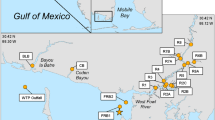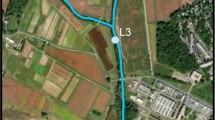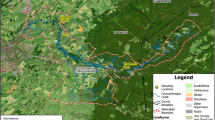Abstract
Abundance of fecal caliform bacteria is a weak index of the presence of human pathogens in wastewater entering coastal waters. In spite of this, use of fecal caliform indices for management purposes is widespread. To gain insight into interpretation of fecal coliform data, we evaluated size of stocks of fecal coliforms in water, sediments, and sea wrack, in Buttermilk Bay, a coastal embayment in Massachusetts. Sediments contained most of the fecal coliforms. Fecal coliforms in sediments were as much as one order of magnitude more abundant than in the water column or in sea wrack. The fecal coliforms in sediments of Buttermilk Bay were so abundant that resuspension of fecal coliforms from just the top 2 cm of muddy sediments could add sufficient cells to the water column to have the whole bay exceed the federal limit of fecal coliforms for shellfishing.
The major sources of fecal coliforms to the bay were water-fowls, surface runoff, groundwater, and streams. Waterfowl were the largest source of fecal coliforms during cold months; surface runoff, streams, and groundwater were most important during warm months. Redirection of surface runoff pipes is unlikely to be a very successful management action since contributions via this source are insufficient to account for the measured increases in concentrations of fecal coliforms in water. Removal of waterfowl is also unlikely to be useful, since fecal coliform concentrations leading to closures of shellfish beds and swimming areas are most frequent during warm months when waterfowl are rarest. Rates of loss of fecal caliform cells from the water column by death and tidal exchange were high. Mortality of cells was about an order of magnitude larger than losses by tidal exchange.
The amounts of fecal coliforms brought into the bay by waterfowl, surface runoff, groundwater, and streams are an order of magnitude smaller than the losses by mortality and tidal removal. This implies that there is an additional source of fecal coliforms within the bay. We suggest that resuspension of the upper layers of sediments can easily account for the fecal coliforms present in the water.
Fecal coliform content of water and shellfish were not correlated. In contrast, sediment and shellfish fecal coliform abundances were significantly related. Monitoring of fecal coliforms in sediments may provide a better assessment of shellfish than sampling of water.
The large fecal coliform stock in sediments should be the first priority for management. Efforts ought to be directed toward the reduction of sediment fecal coliform stocks. Lowering nutrient additions to coastal water bodies may be one practical approach.
Similar content being viewed by others
Literature Cited
Allen, L. A., J. Grindley, and E. Brooks. 1953. Some chemical and bacterial characteristics of bottom deposits from lakes and estuaries.Journal of Hygiene 51:185–194.
APHA (American Public Health Association). 1985. Standard methods for the examination of water and wastewater, 16th ed. American Public Health Association Inc. Washington, DC.
Benton, C. F., F. Khan, P. Monaghan, W. N. Richards, and C. B. Shedden. 1983. The contamination of a major water supply by gulls (Larus sp.).Water Research 7:789–798.
Brown, K. W., H. W. Wolf, K. C. Donnelly, and J. F. Slowley. 1979. The movement of fecal coliforms and coliphages below septic lines.Journal of Environmental Quality 8:121–125.
Buchsbaum, R., and I. Valiela. 1987. Variability in the chemistry of estuarine plants and its effect on feeding by Canada geese.Oecologia 73:146–153.
Burton, G. A., Jr., D. Gunnison, and G. R. Lanza. 1987. Survival of pathogenic bacteria in various freshwater sediments.Applied Environmental Microbiology 53:633–638.
Cabelli, V. J., A. P. Dufour, L. J. McCabe and M. A. Levin. 1983. A marine recreational water quality criterion consistent with indicator concepts and risk analysis.Journal of Water Pollution Control Federation 55:1306–1314.
Carney, J. F., C. E. Carty, and R. R. Colwell. 1975. Seasonal occurrence and distribution of microbial indicators and pathogens in the Rhode River of Chesapeake Bay.Applied Microbiology 30:771–780.
Dufour, A. P.. 1984. Bacterial indicators of recreational water quality.Canadian Journal of Public Health 75:49–56.
Dufour, A. P., E. R. Strickland, and V. J. Cabelli. 1981. Membrane filter method for enumeratingEscherichia coli.Applied Environmental Microbiology 41:1156–1158.
Faust, M. A. 1982. Contributions of pleasure boats to fecal bacteria concentrations in the Rhodes River Estuary, Maryland, U.S.A.The Science of the Total Environment 25:255–262.
Faust, M. A., A. E. Aotaky, and M. T. Hargadon. 1975. Effect of physical parameters on the in situ survival ofEscherichia coli MC-6 in an estuarine environment.Applied Microbiology 30:800–806.
Fish, C. I. 1988. Computer enhanced modelling of tidal velocities and circulation patterns in Buttermilk Bay, MA: A model study and development of methods For general applications. Master's thesis. Boston University, Boston.
Franzblau, S. G., B. Hinnebusch, L. M. Kelley, and N. A. Sinclair. 1984. Effect of noncoliforms on coliform detection in potable groundwater: improved recovery with an anaerobic membrane filter technique.Applied Environmental Microbiology 48: 142–148.
Fujioka, R. S., H. H. Hushimoto, E. B. Suvak, and R. H. F. Young. 1981. Effect of sunlight on the survival of indicator bacteria in seawater.Applied Environmental Microbiology 41:690–696.
Gallagher, T. P., and D. F. Spino. 1968. The significance of numbers of coliform bacteria as an indicator of entering pathogens.Water Research 2:169–175.
Geldreich, E. E., and N. A. Clarke. 1966. Bacterial pollution indicators in the intestinal tract of freshwater fish.Applied Environmental Microbiology 14:429–437
Geldreich, E. E., R. H. Bordner, C. B. Huff, H. F. Clark, and P. W. Kabler. 1962. Type distribution of coliform bacteria in the feces of warm blooded animals.Journal of Water Pollution Control Federation 34:295–301.
Gerba, C. P., and J. S. McLeod. 1976. Effects of sediments on the survival ofEscherichia coli in marine waters.Applied Environmental Microbiology 32:114–120.
Gerba, C. P., E. M. Smith, G. E. Schailberger, and T. D. Edmond. 1979. Field evaluation of methods for the detection of enteric viruses in marine sediments. Pages 64–75in C. D. Litchfield and P. L. Seyfried (ed.), Methodology for biomass determinations and microbial activities in sediment. American Society for Testing and Materials, Philadelphia.
Gilbert, R. G., C. P. Gerba, R. C. Rice, H. Bouwer, C. Wallis, and J. L. Melnick. 1976. Virus and bacterial removal from wastewater by land treatment.Applied Environmental Microbiology 32:333–338.
Green, B. L., E. M. Clausen, and W. Litsky. 1977. Two-temperature membrane filter method for enumerating fecal coliform bacteria from chlorinated effluents.Applied Environmental Microbiology 33:1259–1264.
Hamon, W. R.. 1961. Estimating potential evapotransportation.Journal of Hydraulics Division ACE 87 (HYS):107–120.
Heufelder, G. R. 1988. Bacteriological monitoring in Buttermilk Bay. United States Environmental Protection Agency Technical Report. EPA 503/4-88-001. Washington, D.C., 98 pp.
Hussong, D., J. M. Damare, R. J. Limpert, W. J. L. Sladen, R. M. Weiner, and R. R. Colwell. 1979. Microbial impact of Canada geeseBranta canadensis and whistling swansCygnus columbianus on aquatic ecosystems.Applied Environmental Microbiology 37:14–20.
Kaneko, T. and R. R. Colwell. 1973. Ecology ofVibrio parahemolyticus in Chesapeake Bay.Journal of Bacteriology 113:24–32.
Koppelman, L. E., and E. Tanenbaum. 1982. The Long Island segment of the National Urban Runoff Program. Long Island Planning Board, Hauppauge, New York.
LaBelle, R. L., C. P. Gerba, S. M. Goyal, J. L. Melnick, I. Cech, and G. F. Bogdan. 1980. Relationships between environmental factors, bacterial indicators, and the occurrence of enteric viruses in estuarine sediments.Applied Environmental Microbiology 39:588–596.
LaLiberte, P., and D. J. Grimes. 1982. Survival ofEscherichia coli in lake bottom sediment.Applied Environmental Microbiology 43:623–628.
Lessard, E. J., and J. M. Sieburth. 1983. Survival of natural sewage populations of enteric bacteria in diffusion and batch chambers in the marine environment.Applied Environmental Microbiology 45:950–959.
Lin, S., and R. L. Evans. 1974. An analysis of coliform bacteria in the upper Illinois waterway.Water Resources Bulletin 10:1198–1217.
Mates, A., and M. Shaffer. 1989. Membrane filtration differentation ofEscherichia coli from coliforms in the examination of water.Journal of Applied Bacteriology 67:345–346.
Matson, E. A., S. G. Hornor, and J. D. Buck. 1978. Pollution indicators and other microorganisms in river sediments.Journal of Water Pollution Control Federation 50: 13–19.
McCambridge, J., and T. A. McMeekin. 1981. Effect of solar radiation and predacious microorganisms on survival of fecal and other bacteria.Applied Environmental Microbiology 41:1083–1087.
Moog, P. L. 1987. The hydrogeology and freshwater influx of Buttermilk Bay, Massachusetts, with regard to the circulation of coliforms and pollutants: a model study and development of methods for general application. MS thesis. Boston University, Boston, 166 pp.
Pugsley, A. P. and L. M. Evison. 1974. Immunofluorescence identification of fecal streptococci using commercially-available antisera.Water Research 8:725–728.
Rippey, S., and W. Watkins. 1988. Mt. Hope Bay sanitary survey—microbiological 1986–1987. Report #NBP-88-11 to the Narragansett Bay project.
Rittenberg, S. C., T. Mittwes, and D. Ivler. 1958. Coliform bacteria around three marine sewage outfalls.Limnology and Oceanography 3:101–108.
Savage, W. G. 1905. Bacteriological examination of tidal mud as an index of pollution of the river.Journal of Hygiene 5:146–174.
Shiaris, M. P., A. C. Rex, G. W. Pettibone, K. Keay, P. McManus, M. A. Rex, J. Ebersole, and E. Gallagher. 1987. Distribution of indicator bacteria andVibrio parahaemolyticus in sewage-polluted intertidal sediments.Applied Environmental Microbiology 53:1756–1761.
Struck, P. H. 1988. The relationship between sediment and fecal coliform levels in a Puget Sound Estuary.Journal of Environmental Health 50:403–407.
Toombs, R. W., and D. A. Connor. 1980. Proficiency test sample media for single and mixed pure cultures of water pollution indicator bacteria.Applied Environmental Microbiology 40:883–887.
US Environmental Protection Agency. 1986. Quality criteria for water. Environmental Protection Agency No. 440/5-86-001. US Environmental Protection Agency.
Valiela, I., and J. E. Costa. 1988. Eutrophication of Buttermilk Bay, a Cape Cod coastal embayment: Concentrations of nutrients and watershed nutrient budgets.Environmental Management 12:539–553.
Valiela, I., J. M. Teal, S. Volkmann, D. Shafer, and E. J. Carpenter. 1978. Nutrient and particulate fluxes in a salt marsh ecosystem: tidal exchanges and inputs by precipitation and groundwater.Limnology and Oceanography 23:798–812.
Van Donsel, D. J., and E. E. Geldreich. 1971. Relationship ofSalmonella to fecal coliforms in bottom sediments.Water Research 5:1079–1087.
Wright, R. T., R. B. Coffin, C. P. Ersing, and D. Pearson. 1982. Field and laboratory measurements of bivale filtration of natural marine bacterioplankton.Limnology and Oceanography 27:91–98.
Author information
Authors and Affiliations
Rights and permissions
About this article
Cite this article
Valiela, I., Alber, M. & LaMontagne, M. Fecal coliform loadings and stocks in buttermilk bay, Massachusetts, USA, and management implications. Environmental Management 15, 659–674 (1991). https://doi.org/10.1007/BF02589625
Issue Date:
DOI: https://doi.org/10.1007/BF02589625




